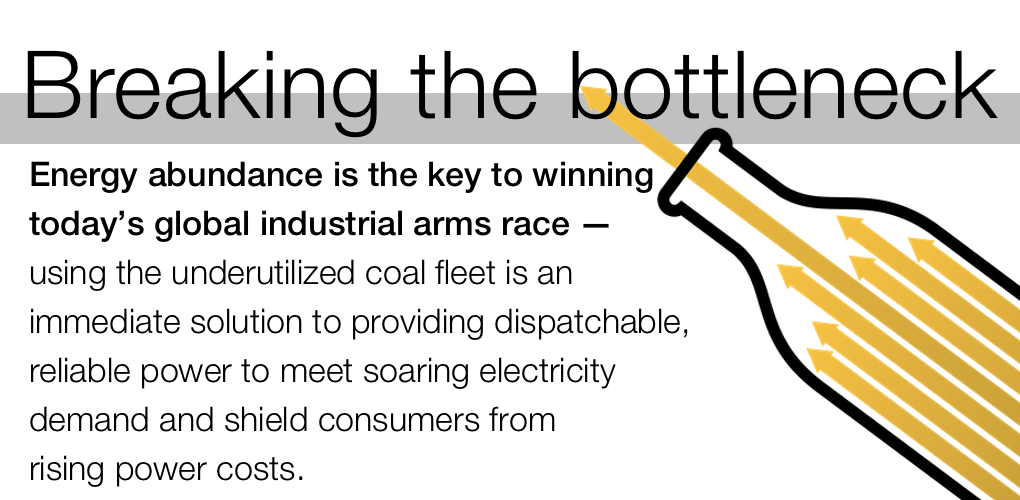
Confronting the AI Electricity Bottleneck
The CEO of NVIDIA, a global leader in AI, recently observed, “Every single data center in the future will be power limited… We are now a power limited industry.”
What he was saying is that electricity is now the key constraint on the development of data centers, the uptake of AI and the economic potential it holds for the nation. How the U.S. manages electricity demand growth and the electricity needs of the AI revolution are arguably the economic and national security challenges of our time. We are in an industrial arms race with China, and this isn’t a race we want to lose.
China is determined not to let electricity be the constraining force in its development and deployment of AI. While China is building record amounts of wind and solar power, the foundation of the Chinese grid remains coal—and Beijing is only doubling down.
Despite already producing and using more coal than the rest of the world combined, China’s power industry began construction on nearly 100 gigawatts (GW) of new coal plant capacity just last year, the most in nearly a decade. For comparison, the entire existing U.S. coal fleet is 175 GW of capacity.
Dispatchable, fuel-secure coal power remains the foundation of China’s industrial strategy, a clear rejection of the missteps that produced Europe’s recent energy crisis and ongoing deindustrialization. Affordable, reliable power is the key that unlocks all doors, and China is using coal to gain a strategic advantage.
The U.S. Races to Keep Up
The Trump administration has inherited an immense challenge. U.S. electricity demand is soaring, and thanks to four years of remarkably damaging policy from the previous administration, the U.S. is already electricity constrained.
Instead of shoring up the nation’s foundering power supply, the Biden team made a tenuous situation far worse by pushing a regulatory agenda to tear down essential dispatchable capacity that far outpaced efforts to bring new generating capacity and enabling infrastructure online.
As scholars from the CSIS research group recently observed in a report titled, “The Electricity Supply Bottleneck on U.S. AI Dominance,” U.S. power supply is so constrained nationally “there is effectively no spare capacity.” That is a colossal problem that is already producing a crippling choke point for the deployment of data centers and threatening significant market disruption for consumers. Power shortages are a recipe for soaring power prices.
The CSIS team projects U.S. data centers will need 84 GW of power by 2030, up from 4 GW last year, a stunning 2100% jump in power demand in just five years. They observe, “Today, access to electricity supply is the binding constraint on… continued U.S. leadership in AI. This fact is demonstrated by a total focus among data center developers on ‘speed-to-power.’” They elaborate: “Speed-to-power is the time it takes a potential data center site to receive access to electricity supply. In Northern Virginia—the nation’s and the world’s largest data center market—speed-to-power is growing worse, as data centers now face electricity supply wait times up to 7 years.”
The Coal Answer
Meeting this demand will require immediate solutions. The Trump administration – to its credit – has rightfully declared an energy emergency to address the collision of this exploding power demand with the rapid erosion of the nation’s grid reliability and power supply.
Doug Burgum, the Secretary of the Interior and Chair of the National Energy Dominance Council, recently observed the coal fleet is a critical piece of the answer. “We’ve got to keep every plant open. And if there have been units at a coal plant that have been shut down, we need to bring those back on,” he said.
CSIS agrees that the coal fleet can be critically important to bridging the power supply gap. They wrote, “in the near-term speed-to-power era, delayed coal retirements make the problem of supplying new AI demand more manageable.” They added, “at the strategic level, the delayed coal retirement strategy buys time.” And time is exactly what we need.
The underutilized coal fleet is an immediate solution to providing dispatchable, reliable power to meet soaring demand and break the bottleneck on data center deployment while shielding consumers from rising power costs. China is leaning on coal to win the AI race. If the U.S. hopes to compete, we can’t fight this battle with one arm tied behind our back.
As Rich Nolan, the National Mining Association’s president and CEO recently observed, “Energy abundance is the key to winning today’s global industrial arms race. The world is using more coal than ever before. It is past time the U.S. recognizes its coal fleet and coal mining industry not as problems to solve but as answers to today’s most pressing challenges.”
- On March 26, 2025
